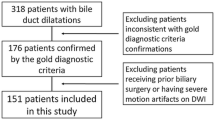Abstract
The purpose was to retrospectively compare two-dimensional (2D) magnetic resonance cholangiography (MRC) including breath-hold single-shot rapid acquisition with relaxation enhancement (RARE) and multislice half-Fourier RARE versus navigator-triggered 3D-RARE MRC in the evaluation of biliary malignancy. MRC findings were evaluated in 31 patients with malignant biliary obstruction, including biliary malignancy, gallbladder carcinoma, and ampullary cancer. Two observers independently reviewed the images to assess the overall image quality, artifacts, ductal conspicuity, extent of disease, diagnostic confidence of tumor extent, and origin of tumor. The results were compared with surgical and histopathologic findings. Studies obtained with 3D-MRC were of significantly higher technical quality than those obtained with 2D-MRC. However, the accuracy between two sequences for classification of tumor showed no statistical significance. There was no significant difference between the Az values of 2D- and 3D-MRC for overall tumor extent in bilateral second order branch, intrapancreatic common bile duct (CBD) involvement (Az = 0.889, 0.881 for 2D and Az = 0.903, 0.864 for 3D). Nor was there a significant difference between two sequences in the assessment of the origin of tumor. Although 3D-MRC has superior image quality over 2D-MRC, 3D-MRC showed no statistically significant difference in accuracy compared with 2D-MRC for evaluating the extent of disease in malignant biliary obstructions.




Similar content being viewed by others
References
Schwartz LH, Coakley FV, Sun Y, Blumgart LH, Fong Y, Panicek DM (1998) Neoplastic pancreaticobiliary duct obstruction: evaluation with breath-hold MR cholangiopancreatography. AJR Am J Roentgenol 170:1491–1495
Becker CD, Grossholz M, Mentha G, de Peyer R, Terrier F (1997) MR cholangiopancreatography: technique, potential indications, and diagnostic features of benign, postoperative, and malignant conditions. Eur Radiol 7:865–874
Schofl R (2001) Diagnostic endoscopic retrograde cholangiopancreatography. Endoscopy 33:147–157
Christensen M, Matzen P, Schulze S, Rosenberg J (2004) Complications of ERCP: a prospective study. Gastrointest Endosc 60:721–731
Frey CF, Burbige EJ, Meinke WB et al (1982) Endoscopic retrograde cholangiopancreatography. Am J Surg 144:109–114
Fulcher AS, Turner MA, Capps GW, Zfass AM, Baker KM (1998) Half-Fourier RARE MR cholangiopancreatography: experience in 300 subjects. Radiology 207:21–32
Varghese JC, Farrell MA, Courtney G, Osborne H, Murray FE, Lee MJ (1999) A prospective comparison of magnetic resonance cholangiopancreatography with endoscopic retrograde cholangiopancreatography in the evaluation of patients with suspected biliary tract disease. Clin Radiol 54:513–520
Soto JA, Barish MA, Yucel EK, Siegenberg D, Ferrucci JT, Chuttani R (1996) Magnetic resonance cholangiography: comparison with endoscopic retrograde cholangiopancreatography. Gastroenterology 110:589–597
Romagnuolo J, Bardou M, Rahme E, Joseph L, Reinhold C, Barkun AN (2003) Magnetic resonance cholangiopancreatography: a meta-analysis of test performance in suspected biliary disease. Ann Intern Med 139:547–557
Hintze RE, Adler A, Veltzke W et al (1997) Clinical significance of magnetic resonance cholangiopancreatography (MRCP) compared to endoscopic retrograde cholangiopancreatography (ERCP). Endoscopy 29:182–187
Mendler MH, Bouillet P, Sautereau D et al (1998) Value of MR cholangiography in the diagnosis of obstructive diseases of the biliary tree: a study of 58 cases. Am J Gastroenterol 93:2482–2490
Vogl TJ, Schwarz WO, Heller M et al (2006) Staging of Klatskin tumours (hilar cholangiocarcinomas): comparison of MR cholangiography, MR imaging, and endoscopic retrograde cholangiography. Eur Radiol 16:2317–2325
Pavone P, Laghi A, Catalano C, Panebianco V, Fabiano S, Passariello R (1999) MRI of the biliary and pancreatic ducts. Eur Radiol 9:1513–1522
Schmidt S, Chevallier P, Novellas S et al (2007) Choledocholithiasis: repetitive thick-slab single-shot projection magnetic resonance cholangiopancreaticography versus endoscopic ultrasonography. Eur Radiol 17:241–250
Coakley FV, Schwartz LH (1999) Magnetic resonance cholangiopancreatography. J Magn Reson Imaging 9:157–162
Sodickson A, Mortele KJ, Barish MA, Zou KH, Thibodeau S, Tempany CM (2006) Three-dimensional fast-recovery fast spin-echo MRCP: comparison with two-dimensional single-shot fast spin-echo techniques. Radiology 238:549–559
Barish MA, Yucel EK, Soto JA, Chuttani R, Ferrucci JT (1995) MR cholangiopancreatography: efficacy of three-dimensional turbo spin-echo technique. AJR Am J Roentgenol 165:295–300
Wielopolski PA, Gaa J, Wielopolski DR, Oudkerk M (1999) Breath-hold MR cholangiopancreatography with three-dimensional, segmented, echo-planar imaging and volume rendering. Radiology 210:247–252
Textor HJ, Flacke S, Pauleit D et al (2002) Three-dimensional magnetic resonance cholangiopancreatography with respiratory triggering in the diagnosis of primary sclerosing cholangitis: comparison with endoscopic retrograde cholangiography. Endoscopy 34:984–990
Bismuth H, Nakache R, Diamond T (1992) Management strategies in resection for hilar cholangiocarcinoma. Ann Surg 215:31–38
Soto JA, Barish MA, Alvarez O, Medina S (2000) Detection of choledocholithiasis with MR cholangiography: comparison of three-dimensional fast spin-echo and single- and multisection half-Fourier rapid acquisition with relaxation enhancement sequences. Radiology 215:737–745
Asbach P, Klessen C, Kroencke TJ et al (2005) Magnetic resonance cholangiopancreatography using a free-breathing T2-weighted turbo spin-echo sequence with navigator-triggered prospective acquisition correction. Magn Reson Imaging 23:939–945
Klessen C, Asbach P, Kroencke TJ et al (2005) Magnetic resonance imaging of the upper abdomen using a free-breathing T2-weighted turbo spin echo sequence with navigator triggered prospective acquisition correction. J Magn Reson Imaging 21:576–582
Acknowledgements
This work was supported by Yonsei University Research Fund of 2007.
Author information
Authors and Affiliations
Corresponding author
Rights and permissions
About this article
Cite this article
Choi, JY., Kim, MJ., Lee, J.M. et al. Magnetic resonance cholangiography: comparison of two- and three-dimensional sequences for assessment of malignant biliary obstruction. Eur Radiol 18, 78–86 (2008). https://doi.org/10.1007/s00330-007-0670-6
Received:
Revised:
Accepted:
Published:
Issue Date:
DOI: https://doi.org/10.1007/s00330-007-0670-6




